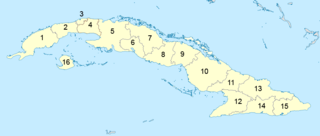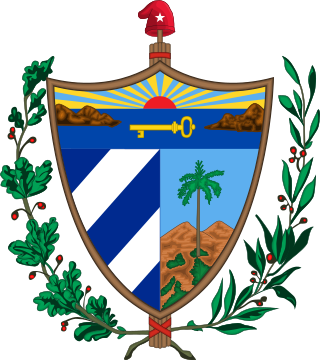
Administratively, Cuba is divided into 15 provinces and one special municipality. The current structure has been in place since August 2010, when the then-La Habana Province was divided into Artemisa Province and Mayabeque Province.

Ciego de Ávila is one of the provinces of Cuba, and was previously part of Camagüey Province. Its capital is Ciego de Ávila, which lies on the Carretera Central, and the second city is Morón, further north.

Ciego de Ávila is a city in the central part of Cuba and the capital of Ciego de Ávila Province. The capital city has a population of about 156,322 and the province 430,507.

Manzanillo is a municipality and city in the Granma Province of Cuba. By population, it is the 14th-largest Cuban city and the most populated one not being a provincial seat.

Nuevitas is a municipality and port town in the Camagüey Province of Cuba. The large bay was sighted by Christopher Columbus in 1492.

Cayo Coco (Cays) or is an island on the north coast of central Cuba, known for its all-inclusive resorts. It lies within the Ciego de Ávila Province and is part of a chain of islands called Jardines del Rey. The cay is administered by the Morón municipality, has a surface area of 370 km2, and is named after the white ibis, locally called coco (coconut) birds. The island is known for its long beaches and many resort hotels.

The Catholic Church in Cuba is part of the worldwide Catholic Church, under the spiritual leadership of the Pope in Rome. Catholics make up approximately half of the population of Cuba.

Tigres de Ciego de Avila is a baseball team in the Cuban National Series. Based in Ciego de Ávila Province, the Tigres have spent most of its history in the bottom reaches of the standings.

Alazanes de Granma is a baseball team in the Cuban National Series, based in the eastern province of Granma. Until the 2016-2017 season, the Alazanes were a frequent contender, but had never advanced to a National Series final. However, in 2017 Granma not only made it to the Cuban National Series final, but swept Ciego de Ávila to win the series, breaking a 40-year record of being seen as underdogs who could not compete with dominant powerhouse teams.
Cayo Romano is an island on the northern coast of Cuba, in the province of Camagüey. It is the largest cay of the Jardines del Rey archipelago with 777 square kilometres (300 sq mi).
The Campeonato Nacional de Liga de Fútbol de Cuba is the top football division in Cuba. Currently, it is contested by 16 clubs and is divided into two tournaments – "Apertura" and "Clausura", with the last being the championship tournament. The champion of each tournament, decided via a playoff match ("Final"), are qualified to Supercopa Nacional de Fútbol de Cuba. The league currently has a fixed membership with each club being a representative of a Cuban province, which makes it one of the football leagues that does not have a promotion and relegation process.

The provinces of Cuba are divided into 168 municipalities. They were defined by Cuban Law Number 1304 of July 3, 1976 and reformed in 2010 with the abrogation of the municipality of Varadero and the creation of two new provinces: Artemisa and Mayabeque in place of former La Habana Province.

Carlos Manuel de Céspedes, also shortened as Céspedes, is a town and municipality in the Camagüey Province of Cuba. It was named for the independence fighter Carlos Manuel de Céspedes (1819-1874).

Primero de Enero is a municipality and town in the Ciego de Ávila Province, Cuba. Originally named Violeta,¿ its name means "1st of January" in Spanish, and is referred to the final day of the Cuban Revolution. It is geographically located in the Northeast of the Province of Ciego de Ávila and has an extension of 712.7 km.
Pablo is a Spanish masculine given name.
Pablo Pacheco Avila is a Cuban journalist who has contributed to the Ciego de Ávila Independent Journalists Cooperative (CAPI). He has been exiled from Cuba since 2010.
Reysander Fernandez Cervantes is a footballer from Cuba who played in the Campeonato Nacional de Fútbol de Cuba and the Canadian Soccer League. He is a former member of the Cuba national football team.
Violeta is the form of the female given name Violet in use in several languages. It can mean:
El Canario is a Cuban village and hamlet belonging to the municipality of Primero de Enero, in Ciego de Avila Province. It has a population of 41.












